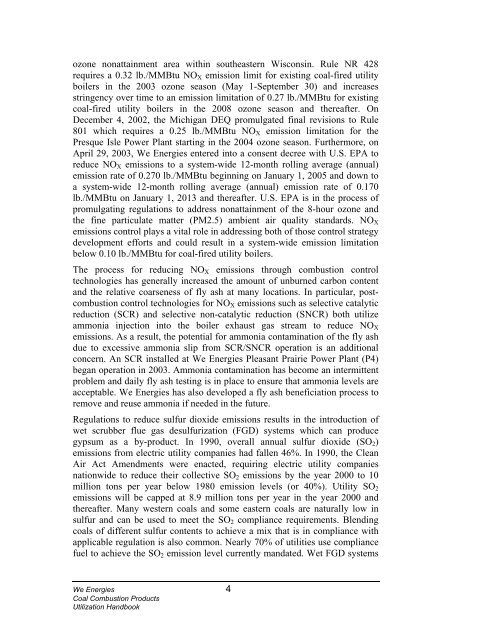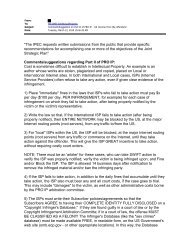We Energies Coal Combustion Products ... - The White House
We Energies Coal Combustion Products ... - The White House
We Energies Coal Combustion Products ... - The White House
You also want an ePaper? Increase the reach of your titles
YUMPU automatically turns print PDFs into web optimized ePapers that Google loves.
ozone nonattainment area within southeastern Wisconsin. Rule NR 428<br />
requires a 0.32 lb./MMBtu NO X emission limit for existing coal-fired utility<br />
boilers in the 2003 ozone season (May 1-September 30) and increases<br />
stringency over time to an emission limitation of 0.27 lb./MMBtu for existing<br />
coal-fired utility boilers in the 2008 ozone season and thereafter. On<br />
December 4, 2002, the Michigan DEQ promulgated final revisions to Rule<br />
801 which requires a 0.25 lb./MMBtu NO X emission limitation for the<br />
Presque Isle Power Plant starting in the 2004 ozone season. Furthermore, on<br />
April 29, 2003, <strong>We</strong> <strong>Energies</strong> entered into a consent decree with U.S. EPA to<br />
reduce NO X emissions to a system-wide 12-month rolling average (annual)<br />
emission rate of 0.270 lb./MMBtu beginning on January 1, 2005 and down to<br />
a system-wide 12-month rolling average (annual) emission rate of 0.170<br />
lb./MMBtu on January 1, 2013 and thereafter. U.S. EPA is in the process of<br />
promulgating regulations to address nonattainment of the 8-hour ozone and<br />
the fine particulate matter (PM2.5) ambient air quality standards. NO X<br />
emissions control plays a vital role in addressing both of those control strategy<br />
development efforts and could result in a system-wide emission limitation<br />
below 0.10 lb./MMBtu for coal-fired utility boilers.<br />
<strong>The</strong> process for reducing NO X emissions through combustion control<br />
technologies has generally increased the amount of unburned carbon content<br />
and the relative coarseness of fly ash at many locations. In particular, postcombustion<br />
control technologies for NO X emissions such as selective catalytic<br />
reduction (SCR) and selective non-catalytic reduction (SNCR) both utilize<br />
ammonia injection into the boiler exhaust gas stream to reduce NO X<br />
emissions. As a result, the potential for ammonia contamination of the fly ash<br />
due to excessive ammonia slip from SCR/SNCR operation is an additional<br />
concern. An SCR installed at <strong>We</strong> <strong>Energies</strong> Pleasant Prairie Power Plant (P4)<br />
began operation in 2003. Ammonia contamination has become an intermittent<br />
problem and daily fly ash testing is in place to ensure that ammonia levels are<br />
acceptable. <strong>We</strong> <strong>Energies</strong> has also developed a fly ash beneficiation process to<br />
remove and reuse ammonia if needed in the future.<br />
Regulations to reduce sulfur dioxide emissions results in the introduction of<br />
wet scrubber flue gas desulfurization (FGD) systems which can produce<br />
gypsum as a by-product. In 1990, overall annual sulfur dioxide (SO 2 )<br />
emissions from electric utility companies had fallen 46%. In 1990, the Clean<br />
Air Act Amendments were enacted, requiring electric utility companies<br />
nationwide to reduce their collective SO 2 emissions by the year 2000 to 10<br />
million tons per year below 1980 emission levels (or 40%). Utility SO 2<br />
emissions will be capped at 8.9 million tons per year in the year 2000 and<br />
thereafter. Many western coals and some eastern coals are naturally low in<br />
sulfur and can be used to meet the SO 2 compliance requirements. Blending<br />
coals of different sulfur contents to achieve a mix that is in compliance with<br />
applicable regulation is also common. Nearly 70% of utilities use compliance<br />
fuel to achieve the SO 2 emission level currently mandated. <strong>We</strong>t FGD systems<br />
<strong>We</strong> <strong>Energies</strong> 4<br />
<strong>Coal</strong> <strong>Combustion</strong> <strong>Products</strong><br />
Utilization Handbook



